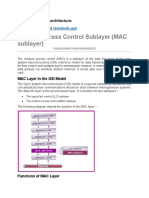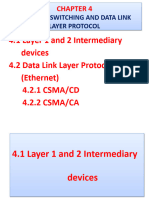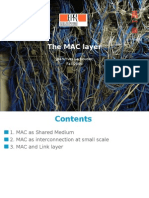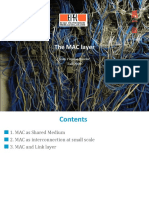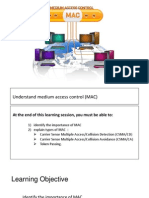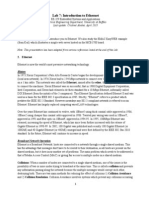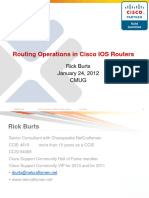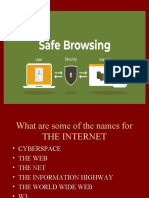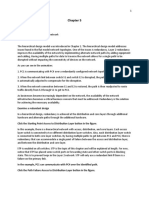Carrier Sense Multiple Access with Collision Detection (CSMA/CD) is a protocol used in wired Ethernet
networks to manage how multiple devices share the same communication medium (e.g., copper cables)
for transmitting data. It helps prevent data collisions and ensures that network devices can
communicate efficiently when they are all connected to a shared medium, such as a local area network
(LAN).
Here are the key notes on CSMA/CD:
1. Basic Concept of CSMA/CD
• Carrier Sense: Before transmitting data, a device on the network "listens" to the channel (also
called the carrier) to check if it is idle or being used by another device. This is known as "carrier
sensing." If the channel is busy (i.e., another device is transmitting data), the device waits until
the channel is free.
• Multiple Access: Multiple devices can access the shared communication medium at any time,
but they must follow a set of rules to avoid interfering with each other’s transmissions.
• Collision Detection: While transmitting, the device monitors the channel to check for
collisions—when two devices transmit simultaneously, their data signals interfere with each
other, causing data corruption. If a collision is detected, the devices stop transmitting, wait for a
random amount of time, and then attempt to retransmit.
2. Steps Involved in CSMA/CD
• Step 1: Listen Before Transmitting (Carrier Sense): The device checks if the channel is idle by
listening for any ongoing transmissions.
o If the channel is idle, the device starts transmitting its data.
o If the channel is busy, the device waits until it becomes idle.
• Step 2: Transmission: Once the channel is idle, the device transmits its data onto the network
medium.
• Step 3: Collision Detection: While transmitting, the device continues to listen to the medium. If
another device starts transmitting at the same time, a collision occurs. The device detects this
collision by comparing the transmitted signal with the signal it is receiving.
• Step 4: Collision Handling: If a collision is detected, both devices involved in the collision:
o Stop transmitting immediately.
o Send a jamming signal to ensure that all devices on the network know that a collision
occurred.
o Wait for a random period before attempting to transmit again. This random delay is
typically determined by the Binary Exponential Backoff algorithm to reduce the
likelihood of repeated collisions.
� • Step 5: Retransmission: After waiting for a random backoff time, the devices attempt to
transmit again, starting from step 1 (listen before transmitting). The backoff time increases if
multiple collisions happen.
3. Key Features of CSMA/CD
• Collision Detection: CSMA/CD is designed to minimize the impact of collisions by detecting them
in real-time and allowing devices to back off and retry transmission after a random delay.
• Efficiency: By allowing multiple devices to share the same communication medium, CSMA/CD
maximizes network efficiency and minimizes wasted bandwidth, although collisions still occur,
especially when network traffic is high.
• Contention-Based Access: CSMA/CD is a contention-based protocol, meaning that devices
compete for access to the shared communication medium. This can lead to delays and collisions,
but it allows for decentralized control and doesn’t require a central coordinator.
• Random Backoff: The random backoff period after a collision ensures that devices do not
continuously collide, allowing them to retry transmission at different times and reduce network
congestion.
4. Advantages of CSMA/CD
• Simple and Efficient: CSMA/CD is a simple and widely used method for managing network
traffic in a shared medium.
• Fairness: It ensures fairness by giving each device an equal chance to transmit data. Devices that
wait for the channel to be idle help avoid congestion.
• Low Overhead: It doesn’t require complex coordination or centralized control, making it
efficient in small to medium-sized networks.
5. Disadvantages of CSMA/CD
• Collisions: Collisions are still possible, especially as network traffic increases. Collisions waste
bandwidth and cause delays.
• Scalability Issues: As the number of devices on a network increase, the likelihood of collisions
rises, leading to decreased performance. This makes CSMA/CD less effective in large networks.
• Not Suitable for High-Speed Networks: CSMA/CD is less efficient at higher speeds because it
takes longer to detect and resolve collisions. This is why modern Ethernet networks that operate
at high speeds (such as gigabit Ethernet) use full-duplex communication, where CSMA/CD is no
longer needed.
6. Evolution of Ethernet and CSMA/CD
• Modern Ethernet: In modern Ethernet networks, especially those using full-duplex transmission
(such as Gigabit Ethernet and beyond), CSMA/CD is no longer necessary. Full-duplex
communication allows devices to send and receive data simultaneously, which eliminates the
possibility of collisions altogether.
� • Switching Technology: With the advent of network switches (instead of hubs), CSMA/CD is
largely obsolete in wired Ethernet networks. A switch creates separate communication paths for
each device, ensuring that collisions don’t occur.
Summary of CSMA/CD:
• Carrier Sense: Listen for idle channel before transmitting.
• Multiple Access: Multiple devices can access the shared channel.
• Collision Detection: Monitor for collisions during transmission.
• Collision Handling: Stop transmission, send a jamming signal, and retry after a random backoff
period.
• Random Backoff: Reduces the chances of repeated collisions by waiting a random time before
retrying transmission.
In summary, CSMA/CD was historically a critical protocol for Ethernet networks to manage shared
communication channels efficiently, but with the advent of modern technologies like full-duplex
communication and network switches, its relevance has diminished in contemporary Ethernet
implementations.

















